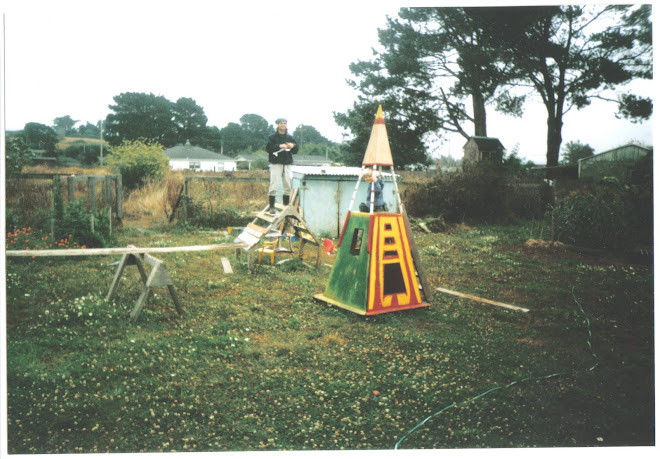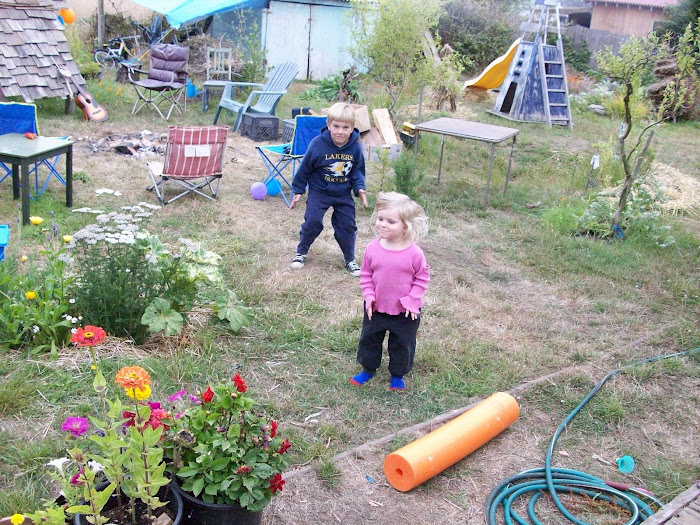
One of our new projects is linking to Japanese-American artist Hiroshi Sunairi's Leur Existence Tree Project, which shares seeds of the hibaku trees with gardeners. Hibaku means "A-bombed" and the seeds come from some of the few trees to survive the bombing of Hiroshima. We'll get our Ginkgo tree seeds and take pictures of our hope-infused seedlings. Then we post the pics here and to Hiroshi's blog alongside hundreds of other gardeners. The picture above is of Sean from New York's Ginkgo sapling.
http://treeproject.blogspot.com/
http://treeproject.blogspot.com/
-------------------------
Our garden is a hive of activity, you might say. Well, first, here's the tent camping site. Such a cozy corner, so private behind blackberry brambles and tall grass. We leveled the ground here and have air mattresses. A compost toilet is in the works. Large, rugged families welcome!

We race to get them lest the pests win. What made this perfect spiral of destruction?
 Probably sow bugs, though snails are garden enemy #1.
Probably sow bugs, though snails are garden enemy #1.Busted! The snail below ate another pumpkin sprout last night.
When you're the only one at the scene of the crime you get the blame.


Evidence of last night's gopher making a mess. More human excavation of this hole to come. And maybe a geologist to map time by studying the layers of soil.

Sunflowers are slowly coming. The first round were eaten by slugs and snails. Still interested in the Great Sunflower Project, we counted bees on rosemary flowers instead. Other flowering plants that could work for this study include bee balm, cosmos, tickseed, and purple coneflower. In 15 minutes we counted what may have been twelve different bees, unless some were repeats. They landed at least those dozen times, if not more on the other side of the bush, for an almost 1 pollination per minute rate. That is much higher than the average rate reported in this study of a pollination every 2.6 minutes. We will keep observing and recording our results in the project's database. I'm sure the beekeepers in the neighborhood help keep our bee population high. Researchers are requesting photos, so we'll be getting some in hopes of identifying which kind of bees are in the yard.
Speaking of raspberries, here is a bowl of berries we hope to sell at the corner store 1 block from our house. I'm sure someone will choose this along with their cigarettes, chocolate bars and six packs. Everything in the bowl is edible. The flowers are delicious nutritious borage blossoms, self-heal/Prunella--what a great plant name (as good as lemon balm/Melissa), lavender, clover and a sprig of mint.
Speaking of raspberries, here is a bowl of berries we hope to sell at the corner store 1 block from our house. I'm sure someone will choose this along with their cigarettes, chocolate bars and six packs. Everything in the bowl is edible. The flowers are delicious nutritious borage blossoms, self-heal/Prunella--what a great plant name (as good as lemon balm/Melissa), lavender, clover and a sprig of mint.
 And one last thing, Frida points to a very slow-growing tadpole. We can't get her a dwarf hamster to live in this cage until these turn into frogs and jump out. We're waiting. . .
And one last thing, Frida points to a very slow-growing tadpole. We can't get her a dwarf hamster to live in this cage until these turn into frogs and jump out. We're waiting. . .














